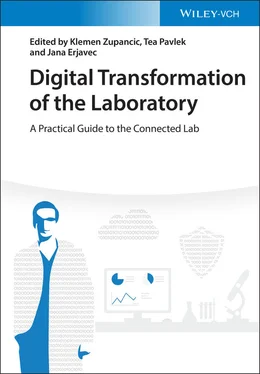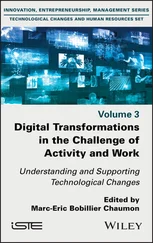From a people and culture perspective, the point we would stress most is the importance of considering the future lab from the perspectives of the different roles working in, around, or in association with the LotF: the scientists – not just the practical hands‐on chemists, biologists, biochemists, physicists, etc. but also the new breed of data scientists and engineers – the lab managers and building managers, the technicians and equipment operators, and all the other staff who will make the LotF an exciting, stimulating, and challenging place to work. The LotF will be more “open,” collaborative, and more automated, if rather more sparse of people. Critical to the LotF's success will be the “UX” of all the people associated with it.
The processes in the LotF will be dominated by flexible automation and robotics, whether that lab is a hypothesis‐driven, research lab, or a manufacturing, testing lab operating more in “LaaS” mode. More effective in silico modeling of the lab processes will make the LotF a safer, more productive place to work.
The lab environment, as well as being designed around large amounts of automation and robotics, flexibly configured, and interconnected, will more often than not be remote from the “customers” of the work actually being done. Good data and network interconnectedness of the LotF will be absolutely critical if it is to operate effectively and securely. The LotF will also be a markedly more sustainable and greener environment.
The data generated by the LotF, whether it is the “raw” data coming off the instruments or the “refined” result data derived from the raw data, will continue to be key to the LotF; if anything, the criticality and value of the digital assets generated by LotFs will become even more important in the future. Data‐focused technologies and standards such as IoT, FAIR, SiLA, and Allotrope will ensure that the high‐value digital assets are well managed and secured. The increasing focus on data privacy, security, and protection will put heavy pressure on LotFs with regard to good governance and compliance.
Finally, when considering new technologies such as AI/ML and quantum computing, and new science such as CRISPR and CAR‐T, we feel we cannot overstress that science, technology, research, and development never cease to evolve. New discoveries are being made constantly, and these will without doubt have an impact on the LotF in ways we cannot predict now, in 2021. We can state quite confidently that there will be some technologies or scientific discoveries we have not mentioned here, which will affect significantly what happens in the labs of the future. We have highlighted those we feel now are important to help guide and stimulate you, the reader as you try to understand where and how the LotF is likely to develop. There will be others. In fact during 2020 a number of the themes and directions we have highlighted in this chapter have come to pass as the world has grappled with the momentous events surrounding the SARS‐CoV‐2 (COVID‐19) pandemic. The pace of scientific and medical response to understanding the virus and its treatment has been unparalleled. Global, open and collaborative sharing of data and information on the virus itself, on the epidemiology of the disease, on its acute treatment through, for example, accelerated drug repurposing and the development of an effective vaccines, has allowed enormous progress to be made towards helping the control of the virus [112]. New technology has also enabled safer lab working to cope with COVID-19 restrictions (e.g. equipment booking, lab capacity planning, remote access to instruments supporting home working, and tracking of contacts). Technology and automation have supported the faster establishment of new test facilities, but there have been differences in approach between larger and smaller local labs, and between different countries, e.g. between Germany and UK (in the UK these are known as “Lighthouse Labs” [113]). And new science has played a huge role in the development of the many potential vaccines currently being progressed and trialled in labs and clinics across the world [114]. Nevertheless, despite this explosion of cross-border, cross-research group and company collaboration, there have still been challenges around speed of data sharing, data accuracy and trust in the information being disseminated widely, particularly as that sharing has often happened without or before robust peer review [115]. This tells us that there is still a long road ahead on the LotF journey. Most assuredly though, the lab of the future in say, 2030, will be very different from the lab of 2020; but it will be a fascinating, exhilarating and safer place, not only to work, but also to have your work done, and to do new science.
1 1 Deloitte Tackling digital transformation. (2019). https://www2.deloitte.com/us/en/insights/industry/life-sciences/biopharma-company-of-the-future.html(accessed 1 February 2020).
2 2 Shandler, M. (2018). Life science's lab informatics digital criteria to separate vendor leaders from laggards. Gartner G00336151. https://www.gartner.com/en/documents/3895920/life-science-s-lab-informatics-digital-criteria-to-separ(accessed 1 February 2020).
3 3 Open Science Massively Open Online Community (MOOC) https://opensciencemooc.eu/(accessed 1 February 2020).
4 4 Vidyasagar, A. (2018). What is CRISPR? https://www.livescience.com/58790-crispr-explained.html(accessed 1 February 2020).
5 5 Open Science https://openscience.com/(accessed 1 February 2020).
6 6 Tapscott, D. and Tapscott, A. (2016). Blockchain Revolution. New York. ISBN: 978‐0‐241‐23785‐4: Penguin Random House.
7 7 Shute, R.E. (2017). Blockchain technology in drug discovery: use cases in R&D. Drug Discovery World 18 (October Issue): 52–57. https://www.ddw-online.com/informatics/p320746-blockchain-technology-in-drug-discovery:-use-cases-in-r&d.html.
8 8 Gawas, A.U. (2015). An overview on evolution of mobile wireless communication networks: 1G‐6G. International Journal on Recent and Innovation Trends in Computing and Communication 3: 3130–3133. http://www.ijritcc.org.
9 9 Chovan, T. and Guttman, A. (2002). Microfabricated devices in biotechnology and biochemical processing. Trends in Biotechnology 20 (3): 116–122. https://doi.org/10.1016/s0167-7799(02)01905-4.
10 10 Zimmerman, J.B., Anastas, P.T., Erythropel, H.C., and Leitner, W. (2020). Designing for a green chemistry future. Science 367 (6476): 397–400. https://doi.org/10.1126/science.aay3060.
11 11 (i) Notman, N. (2018). Seeing drugs in 3D. Chemistry World (April Issue) https://www.chemistryworld.com/features(accessed 1 February 2020). (ii) Chapman, K. (2020). 3D printing the future. Chemistry World (February Issue). https://www.chemistryworld.com/features/3d-printing-in-pharma/3008804.article(accessed 1 February 2020).
12 12 23andMe https://www.23andme.com/(accessed 1 February 2020).
13 13 Ancestry https://www.ancestry.com/(accessed 1 February 2020).
14 14 Plowright, A., Johnstone, C., Kihlberg, J. et al. (2011). Hypothesis driven drug design: improving quality and effectiveness of the design‐make‐test‐analyse cycle. Drug Discovery Today 17: 56–62. https://doi.org/10.1016/j.drudis.2011.09.012.
15 15 Tawfik, M., Salzmann, C., Gillet, D., et al. (2014). Laboratory as a service (LaaS): a model for developing and implementing remote laboratories as modular components. 11th International Conference on Remote Engineering and Virtual Instrumentation. IEEE. https://doi.org/10.1109/REV.2014.6784238.
16 16 Data Center Container (2019). https://www.techopedia.com/definition/2104/data-center-container(accessed 1 February 2020).
17 17 Francis Crick Institute https://www.crick.ac.uk/about-us/our-vision(accessed 1 February 2020).
Читать дальше











